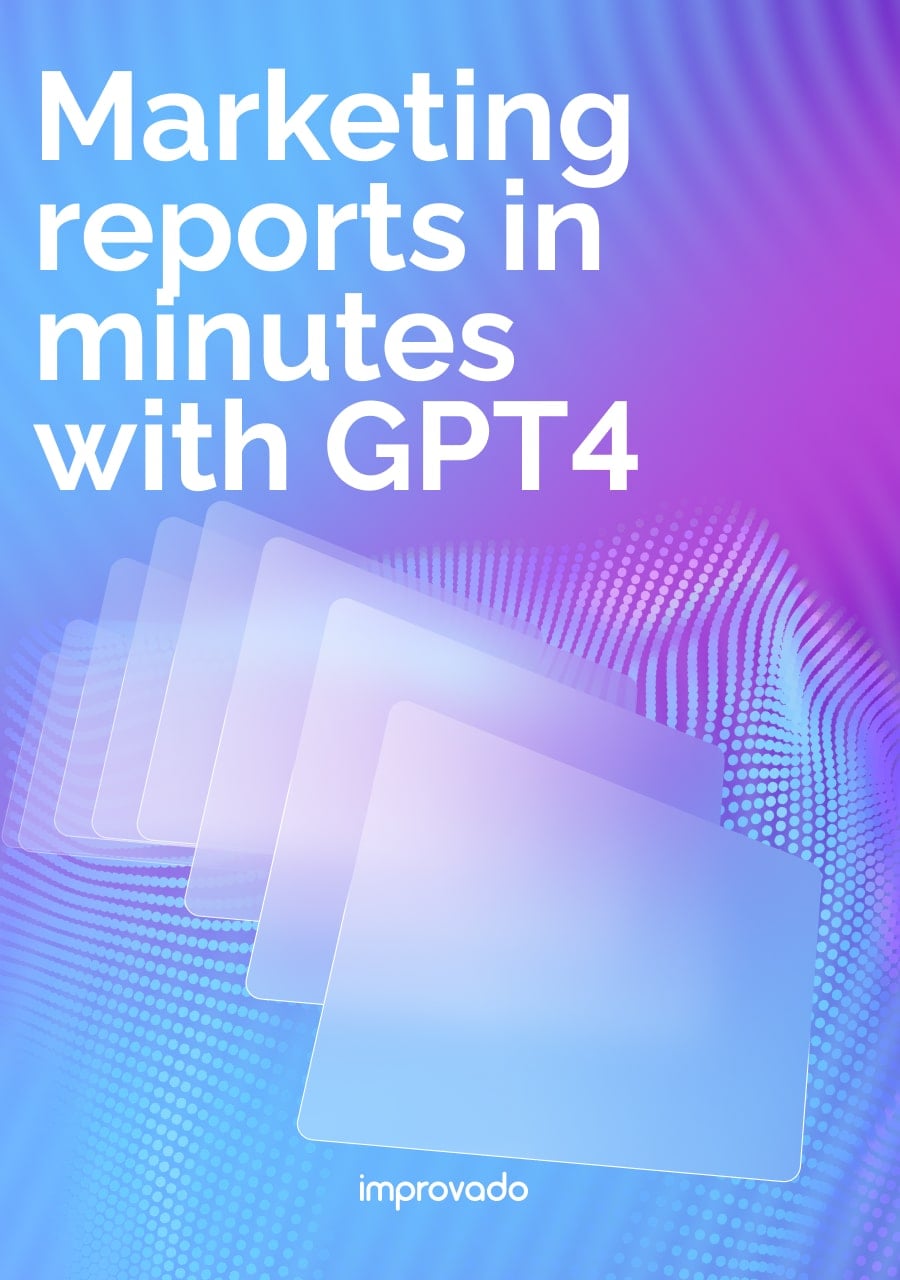Most analytics teams face a common challenge: growing volumes of marketing and business data, but limited time and resources to extract insights that drive action. Traditional BI tools fall short when real-time decisions, cross-channel visibility, and predictive capabilities are required.
This article explores the new generation of analytics solutions—AI analytics platforms, how they work, what sets them apart, and how to evaluate the right solution for your stack. It also covers leading platforms on the market, including their AI capabilities and use cases.
What Is an AI Analytics Platform?
AI Data Analytics vs Traditional Tools
Unlike traditional BI tools that rely heavily on static dashboards and manual queries, AI analytics platforms surface trends, correlations, and anomalies in real time. They adapt to changes in the data, continuously learn from usage patterns, and can suggest or even take next-best actions automatically.
Ultimately, AI helps teams shift from reactive to proactive data analysis, from retrospective reporting to real-time decision-making.
Here's a closer look at the differences between AI analytics tools and traditional solutions.
| Aspect | Traditional analytics tools | AI analytics platforms |
|---|---|---|
| Insight generation | Manual, based on predefined queries or dashboards | Automated, with AI surfacing trends, anomalies, and recommendations |
| Data volume handling | Requires data sampling or performance tuning at scale | Built to process large, complex datasets in real time |
| User accessibility | Requires technical skills to explore and interpret data | Supports natural language queries and intuitive interfaces |
| Speed to insight | Slower, depends on analyst availability and manual setup | Faster, with real-time alerts and dynamic insights |
| Forecasting | Limited or requires separate modeling tools | Built-in machine learning models for trend prediction and scenario planning |
| Optimization support | Descriptive reporting only | Prescriptive recommendations (e.g., budget shifts, channel adjustments) |
| Scalability across teams | Challenging without custom dashboards and training | Easier to scale insights with AI-driven explanations and automation |
Augmented analytics and AI agents
While AI analytics platforms represent a major leap forward from traditional analytics tools, augmented analytics and AI agents are the next evolution, pushing the boundaries of what AI can do in data-driven decision-making.
These technologies are fundamentally changing how insights are delivered and consumed. Let's break down each concept.
Augmented analytics isn't a standalone product but a core capability of modern AI analytics platforms. It automates data preparation, surfaces statistically significant patterns, and generates dynamic narratives and visualizations, all without manual querying.
The result? Faster insights, fewer blind spots, and broader access to analysis across teams.
Within this framework, AI agents serve as the interface between data and decision-makers.
AI agents enable users to interact with data using natural language, generate on-demand reports, receive proactive alerts, and even trigger actions across connected tools. By reducing dependence on analysts for routine tasks, they deliver real-time answers to complex questions like: "Which channels underperformed this week?" or "What's the predicted CAC for Q3?"
How AI Analytics Platforms Work?
AI analytics platforms combine traditional data analytics with automation, machine learning, and intelligent interfaces to accelerate how data is processed, interpreted, and acted on.
At their core, AI analytics platforms integrate multiple technologies. Below are the foundational components that make this possible.
1. Predictive models and machine learning
AI analytics platforms use machine learning models to identify patterns in historical data and forecast future outcomes. These models can predict metrics like customer lifetime value, churn risk, conversion probability, or campaign ROAS without needing separate data science infrastructure.
As more data is ingested, models self-improve, refining accuracy and adjusting to shifts in customer behavior, channel mix, or market conditions. This allows teams to run "what-if" scenarios, evaluate potential budget reallocations, or proactively address underperformance before it impacts revenue.
2. Natural language queries and AI assistants
A hallmark of AI analytics platforms is their ability to let users interact with data in more natural, intelligent ways.
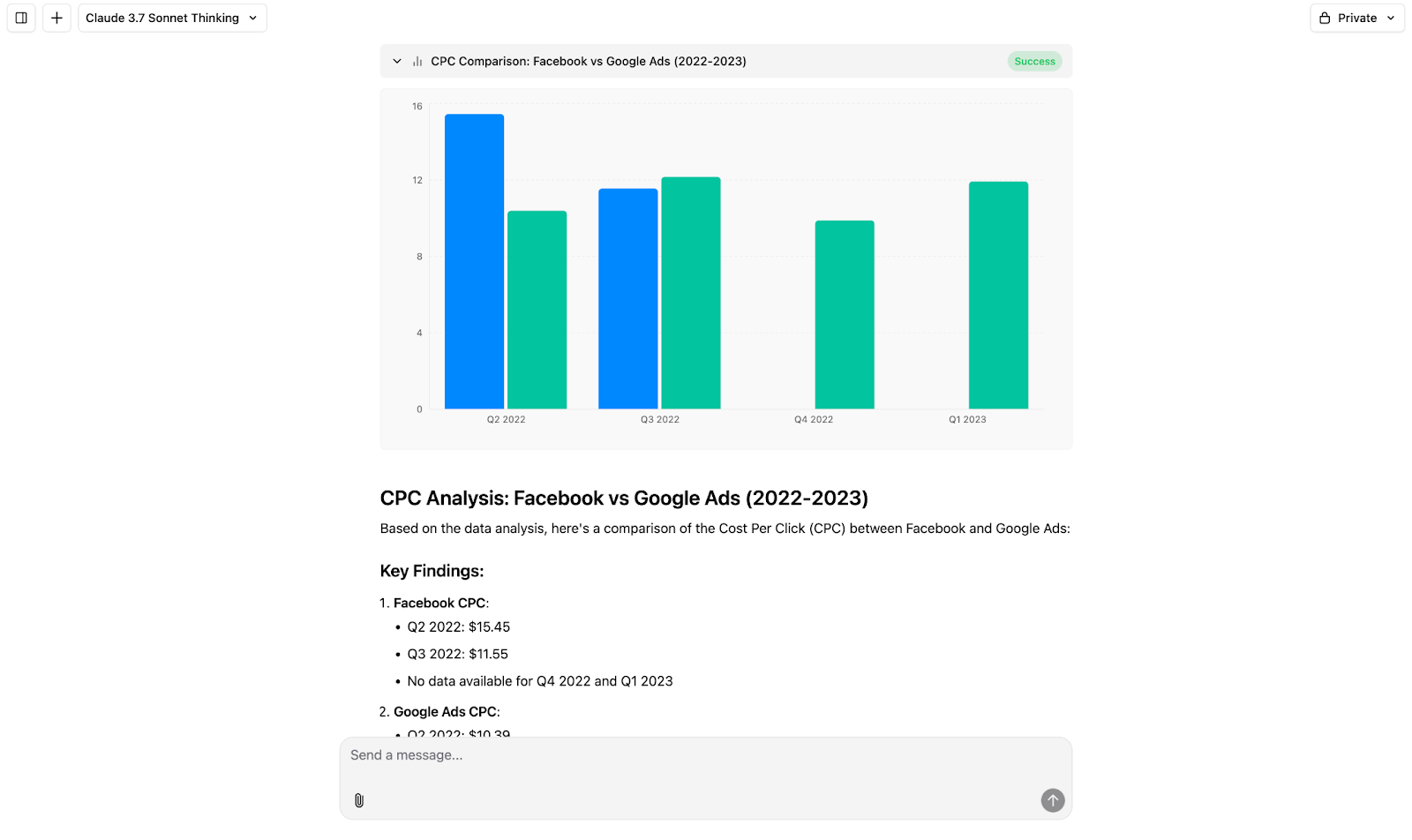
Many offer natural language processing (NLP) or natural language query (NLQ) capabilities and AI-powered assistants directly into the interface. This lowers the barrier to ad-hoc analysis, enabling non-technical users to explore data through Google-like search rather than complex BI tools.
Under the hood, the platform’s machine learning capabilities may automatically run algorithms to determine the “why” behind trends – performing root cause analysis, segmenting audiences, or finding key drivers of metrics without requiring a data scientist.
3. Data integration and data quality
The quality of the AI analytics tools' output is a direct reflection of the quality of the data.
To support machine learning models, predictive algorithms, and real-time recommendations, AI analytics platforms must ingest data from multiple systems, including advertising platforms, CRM tools, web analytics, call tracking, CDPs, and data warehouses. This data must be normalized, deduplicated, and aligned around consistent dimensions to enable accurate analysis.
Poor data quality undermines model performance, distorts forecasts, and triggers false positives in anomaly detection.
On the other hand, high-integrity data enables AI systems to detect meaningful patterns, surface reliable insights, and drive automation without manual validation.
4. Automated anomaly detection and alerts
One of the most strategic capabilities of AI analytics platforms is automated anomaly detection—the ability to continuously monitor metrics, identify deviations from expected patterns, and surface issues in real time without manual oversight.
Unlike static threshold-based alerting, AI-driven anomaly detection leverages statistical models and machine learning to understand baseline behaviors across campaigns, channels, and segments. It dynamically adjusts for seasonality, time-of-day patterns, and cross-metric dependencies to minimize noise and highlight only meaningful anomalies.
These systems can detect unusual spikes or drops in performance metrics, such as ROAS, CAC, or conversion rate, and contextualize the anomaly by identifying potential drivers, impacted dimensions (for example, channel, geo, product), and severity.
5. Smart Recommendations and Decision Support
Beyond showing what’s happening, AI analytics platforms offer recommendations on what to do next. These suggestions are based on pattern recognition, benchmarking, and predictive modeling.
Examples include:
- Suggested budget reallocations to improve ROAS,
- Audience segments likely to convert,
- Campaigns that should be paused due to declining performance,
- Channels underutilized relative to historical benchmarks.
This decision-support capability moves the platform from passive reporting to active strategic enablement.
What Are the Key Benefits of Using an AI Analytics Platform?
AI analytics tools are more than just a faster way to report. They represent a fundamental shift in how organizations approach data-driven decision-making.
Below are the key benefits driving adoption across high-performing organizations.
1. Accelerated time to insight
Traditional analytics workflows often involve delays: waiting on data pulls, building custom dashboards, or manually reviewing reports.
AI analytics platforms eliminate these bottlenecks by continuously ingesting data and delivering instant insights as soon as patterns emerge.
This dramatically reduces the time between data collection and action, enabling faster optimization and real-time course correction.
2. Reduced dependence on data teams
Even with modern BI infrastructure, many analysts spend a disproportionate amount of time managing ad hoc requests, building dashboards, or stitching together data for stakeholders.
With built-in natural language interfaces, AI report generation, and AI assistants, non-technical users can access advanced insights without relying on analysts or writing queries. Whether it's identifying underperforming campaigns, checking channel ROAS, or exploring customer behavior trends, users can interact with the data directly without submitting tickets or waiting for days.
3. Deeper insights and pattern detection
AI algorithms excel at sifting through large, complex datasets to find non-obvious patterns or correlations that humans might miss.
For example, an AI platform might discover hidden segments of customers with unusual behavior, or pinpoint which combination of channel, message, and timing drives a spike in engagement.
These tools uncover insights beyond surface-level metrics, providing a richer understanding of customer behavior and campaign performance. Marketers can leverage such insights to personalize experiences and refine targeting strategies with a new level of granularity.
4. Intelligence layer on top of existing dashboards
Dashboards alone don't solve the problem of strategic decision-making. They present data, not direction.
An AI analytics platform adds a critical intelligence layer, transforming passive reporting into active insight generation.
For example, instead of simply showing a drop in ROAS, the AI layer can automatically attribute the decline to a specific audience shift, budget reallocation, or drop in conversion rate from a key region, and do so in near real-time.
It also provides contextual recommendations, such as adjusting spend caps or rebalancing channel mix, helping teams move from observation to execution without delays.
This capability turns existing dashboards from static summaries into decision-enabling tools.
5. Scalable reporting for stakeholders at every level
Executive leadership, finance, and marketing operations often require different levels of reporting.
AI analytics platforms allow organizations to deliver role-specific reporting from a unified data layer without duplicating work or creating custom dashboards for each team.
Through user-level permissions and dynamic content rendering, the platform tailors output automatically.
- Executives see condensed summaries focused on revenue, ROI, and pacing.
- Channel leads get performance by campaign, audience, or region.
- Analysts can drill into raw metrics, attribution paths, or model outputs.
This structure ensures alignment across teams while maintaining control over metric definitions, access, and data logic. Everyone works from the same source; what differs is the depth, context, and frequency of delivery.
Top 7 AI Analytics Platforms to Know
With numerous analytics tools on the market, it’s helpful to zero in on a handful of leading platforms that demonstrate strong AI capabilities and are designed specifically for enterprise marketing teams.
| Tool | Focus | Notable AI Analytics Features |
|---|---|---|
| Improvado | Enterprise marketing analytics | AI Agent, smart recommendations, anomaly alerts, automated reporting, naming conventions governance |
| Tellius | AI-powered BI and search-driven analytics | Natural language search, automated insights, root cause analysis, no-code AutoML |
| Alteryx | Analytics automation and ML workflows | AutoML, NLP, explainable AI, text mining, Python/R integration |
| Domo | Cloud BI and real-time performance monitoring | AutoML, NLP (Magic ETL), AI alerts, AI-powered data stories |
| ThoughtSpot | Search-first analytics and live query engine | Search-driven queries, SpotIQ for AI insights, anomaly detection, federated search |
| Tableau | Visual analytics and embedded AI | Explain Data, Ask Data (NLP), Einstein Discovery, AI forecasting |
| Power BI | Enterprise BI with Microsoft ecosystem integration | Natural language QA, key influencers, anomaly detection, AutoML, smart narratives |
1. Improvado

Improvado is an AI-powered marketing analytics and intelligence platform designed to centralize, cleanse, and activate data from any source: ad platforms, CRM systems, web analytics, call tracking, and data warehouses. It provides teams with a single source of truth, enabling consistent performance monitoring and end-to-end attribution without manual work.
Key features:
- AI Agent: It's a natural language processing tool that provides instant answers to performance questions, visualizations, anomaly detection, and prescriptive recommendations. The Agent is model-agnostic, allowing users to switch between models for various task types. Organizations can customize the Agent, feeding it their business context, custom metrics, and other relevant data.
- AI report generation: Automatically generates campaign, channel, or performance reports based on user prompts or scheduled logic, reducing time spent on manual analysis.
- Marketing Data Governance: Prebuilt and customizable rule library (250+ rules) for spend and metric pacing, naming conventions, UTM compliance, and more, with real-time alerts and QA.
- Unified data schema: Seamless integration with 500+ marketing platforms, transforming and aligning data across channels for consistency. A robust data pipeline feeds reporting and AI models, ensuring teams can trust their dashboards and insights.
- Naming Conventions Module: AI-powered system automatically audits and corrects campaign naming inconsistencies across all major ad platforms, including Google Ads, Meta, Bing, The Trade Desk, and TikTok, and then syncs the clean, standardized names back to those platforms
2. Tellius
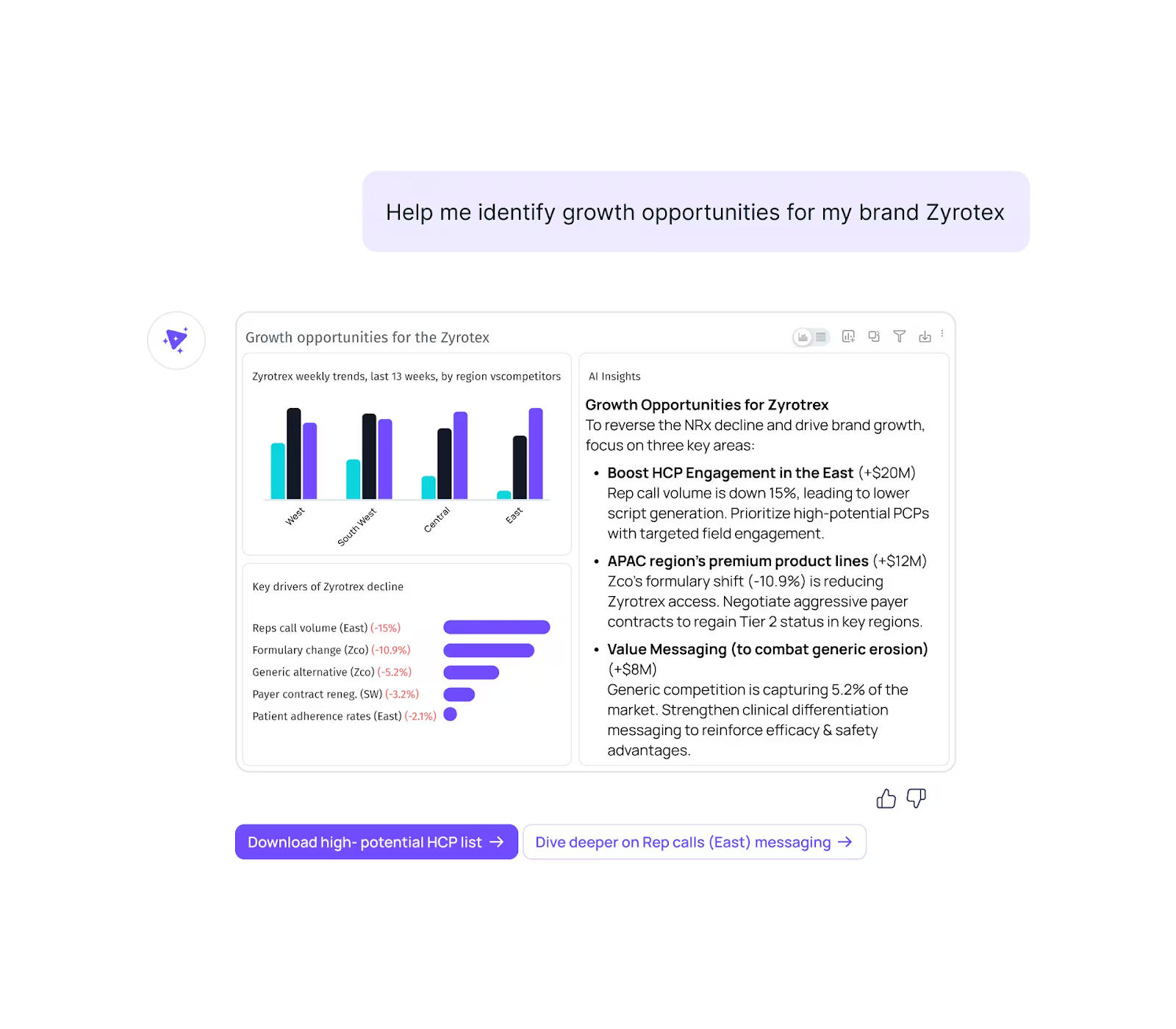
Tellius is an AI-driven augmented analytics and decision intelligence platform with a Google-like search interface, allowing users to simply ask questions or type keywords to analyze billions of records and discover insights.
Key features
- Natural language querying: Users can explore data and generate visualizations by typing questions in plain English, reducing dependency on technical teams.
- Automated root cause analysis: The platform identifies factors that contribute to metric changes by scanning across dimensions and highlighting statistically relevant drivers.
- Anomaly detection: Tellius continuously monitors selected metrics and flags deviations from expected patterns, helping to surface performance outliers.
- Predictive modeling and AutoML: Built-in machine learning tools allow users to build, train, and evaluate predictive models using a guided, no-code workflow.
- Agent-based workflows: Supports reusable, multi-step analyses through configurable “agent” flows that can automate recurring diagnostic or reporting tasks.
3. Alteryx
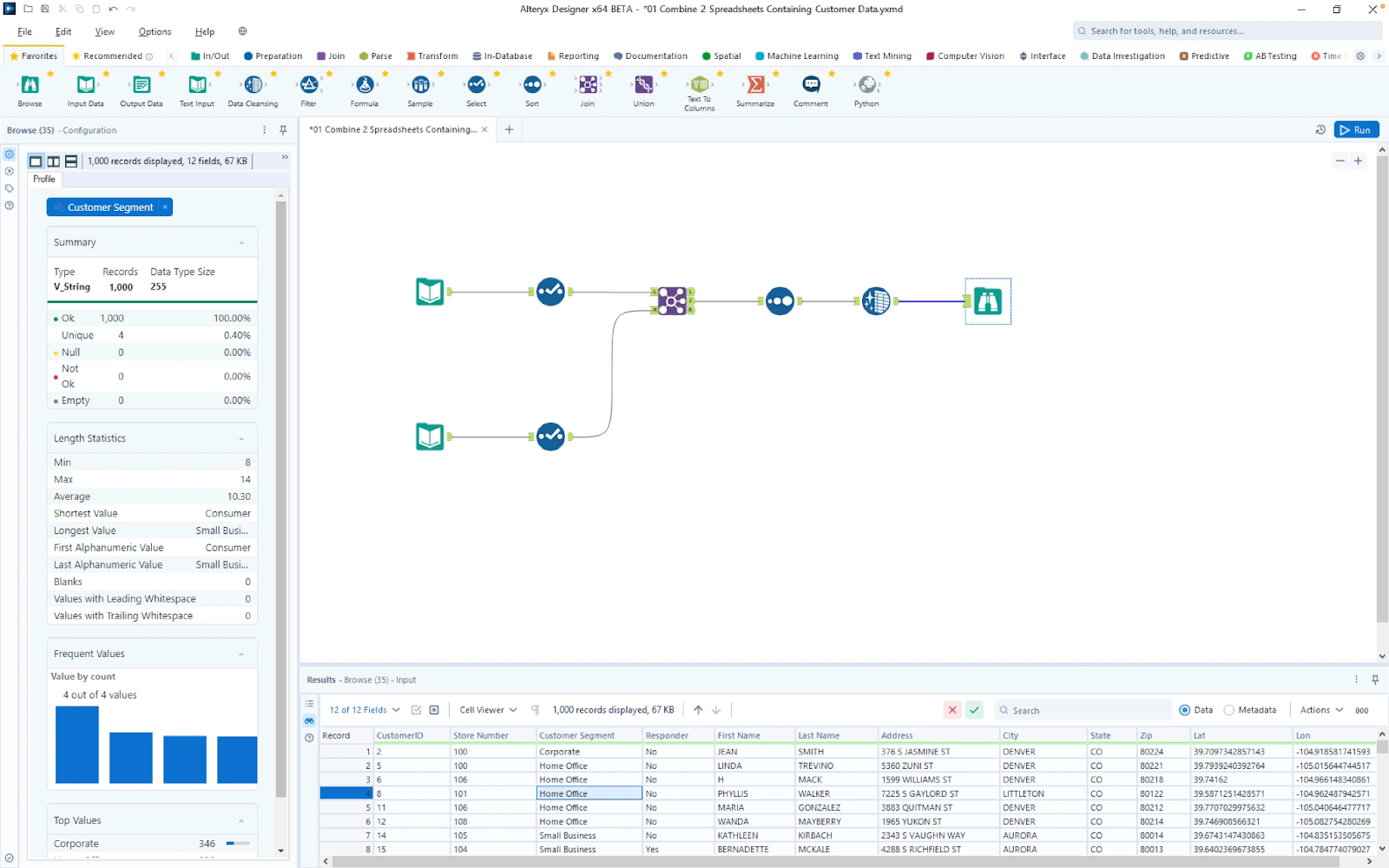
Alteryx is an end-to-end analytics platform that combines data preparation, integration, and machine learning into a visual workflow environment.
Key features:
- Visual workflow builder: Drag-and-drop interface for data preparation, blending, enrichment, and analytics, with full transparency into each transformation step.
- Integrated intelligence suite: Offers tools for feature engineering, model comparison, and explainability, helping non-technical users interpret model outputs.
- Text mining and natural language processing: Supports sentiment analysis, topic modeling, and keyword extraction for unstructured data.
- AI-powered recommendations: Leverages historical usage patterns to suggest next steps in workflows and accelerate repetitive analysis tasks.
- Model management and deployment: Supports versioning, validation, and deployment of models into production environments with scheduling and automation.
- Explainable AI support: Helps users understand how input variables influence model predictions, enabling more transparent decision-making.
4. Domo
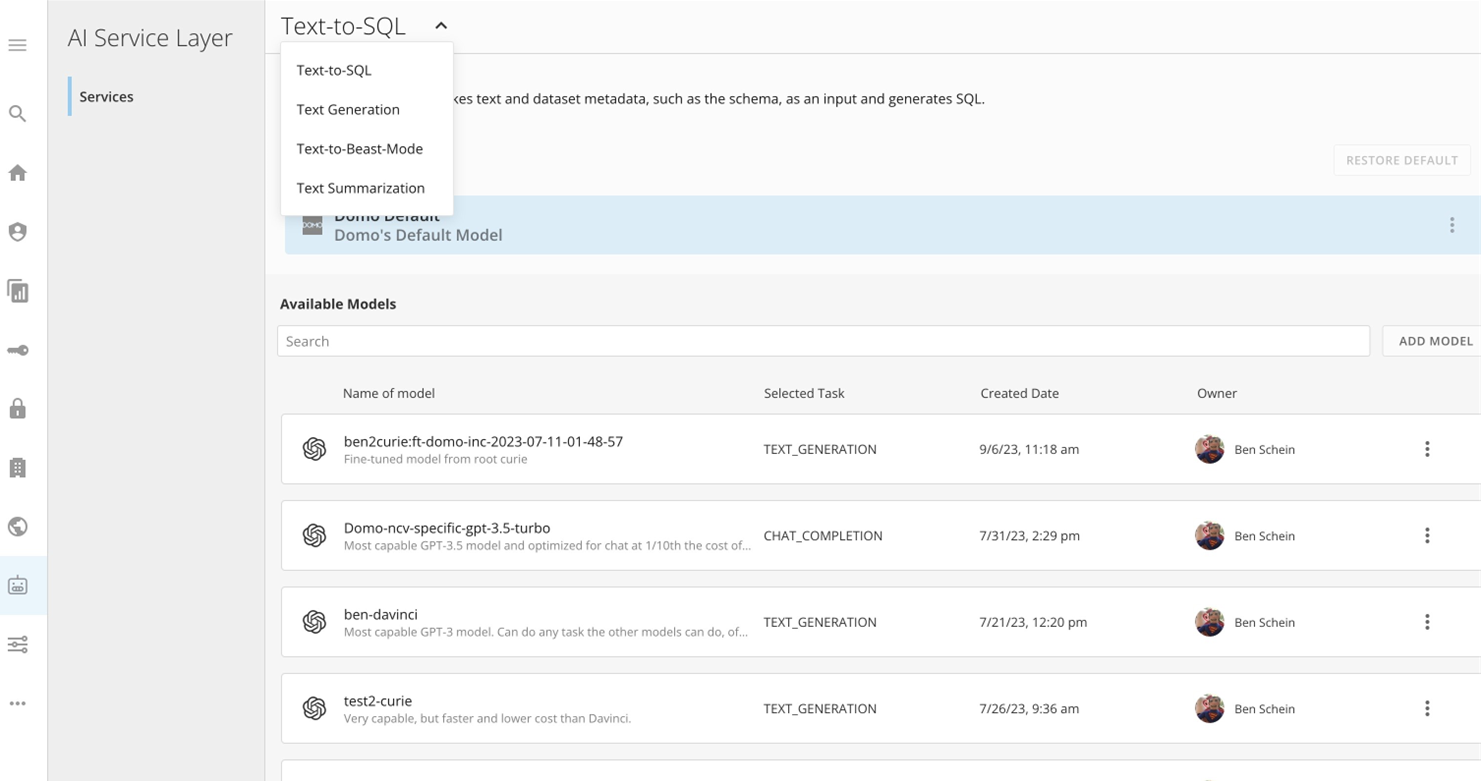
Domo is a cloud-native analytics platform that embeds AI and machine learning into the full data lifecycle, from ingestion and preparation to insight generation and action.
Key features:
- AutoML and predictive analytics: Offers point-and-click model building and evaluation, enabling users to forecast metrics like conversion trends, customer churn, and revenue performance without coding.
- DataFlow AI enhancements: Enhances ETL workflows with AI-powered data cleansing, anomaly detection, and enrichment steps that automatically identify outliers, missing values, and domain-specific patterns.
- Natural language processing (Magic NLP): Allows users to ask questions in natural language and instantly generate charts, tables, and narrative summaries, reducing reliance on technical teams.
- Smart alerts: Continuously monitors metrics and triggers intelligent alerts when anomalies are detected, providing context about what changed and including recommended corrective actions.
- Integration with external AI tools: Connects seamlessly with external Jupyter notebooks, SageMaker, or other AI services to incorporate custom models and advanced data science workflows into visual storyboards.
5. ThoughtSpot
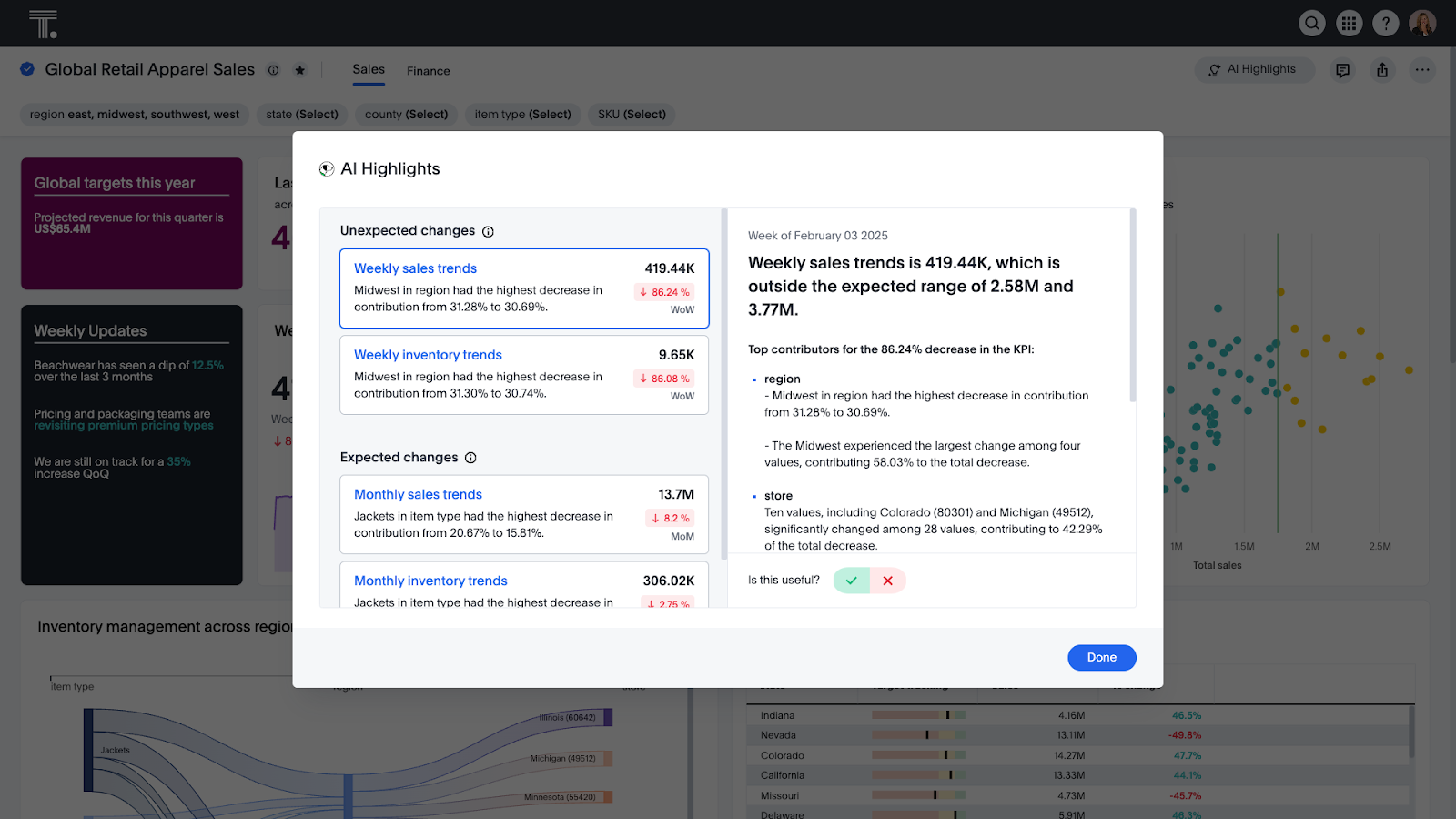
ThoughtSpot is a search-based analytics platform that enables users to interact with large datasets through conversational queries and receive immediate, AI-curated answers.
Key features:
- Search-driven analytics: Users type questions like “What is our ROAS by channel last quarter?” and ThoughtSpot instantly generates visuals and summaries powered by AI query understanding.
- Automated insight generation: The platform continuously scans data to surface meaningful patterns, unexpected correlations, and performance shifts, helping identify root causes without manual exploration.
- SpotIQ AI engine: Automatically analyzes selected datasets for outliers or trends, generating contextual presentations such as charts, graphs, and narrative highlights that reveal what moves the metrics.
- Smart recommendations: Following anomaly detection, ThoughtSpot suggests next steps, such as drilling into specific segments, adjusting timeframes, or exploring related metrics, to guide further analysis.
- AI-augmented dashboards: Dashboards are enhanced with embedded search bars, auto-generated insights, and customizable alerts, making it easy to discover and act on data directly from visual reports.
- Federated search across systems: A single search interface can query related data across connected systems like CRM, ad platforms, data lakes, or ERP.
6. Tableau
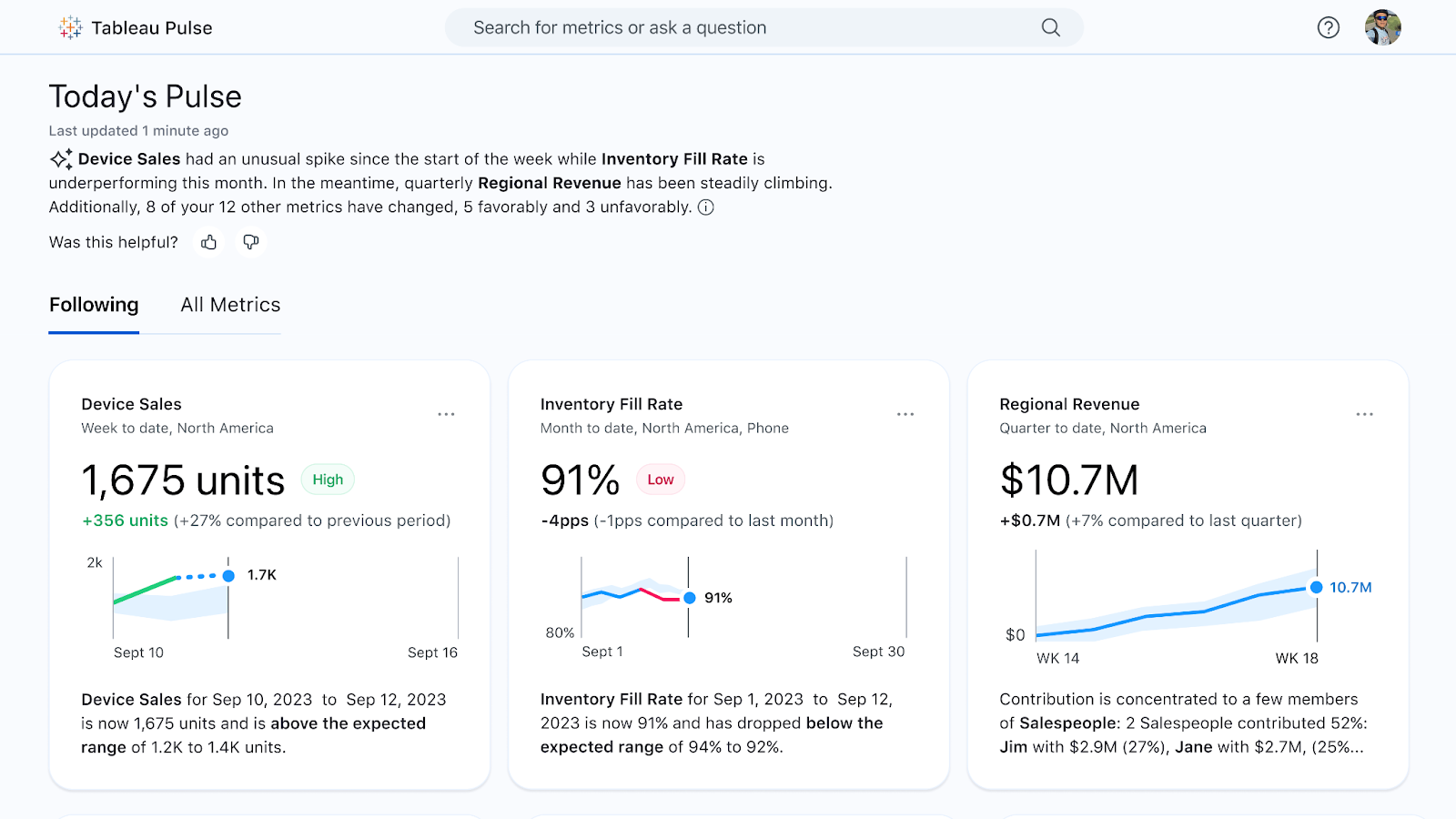
Tableau is a business intelligence platform that has enhanced its analytics capabilities with AI-powered features.
Key features:
- Ask Data (Natural Language Querying): Users can type questions like "Sales by region last quarter" into a search bar and receive instant charts and tables. The system translates plain-language queries into visual insights.
- Explain Data (Automated insight suggestions): Tableau analyzes selected data points, surfaces possible reasons behind outliers or trends, and suggests relevant dimensions or metrics for further exploration.
- Einstein Discovery in Tableau CRM: Integrated with Salesforce's AI engine, this feature enables predictive modeling, scenario analysis, and recommendations —such as predicting customer churn or forecasting campaign performance —directly within dashboards.
- Smart predictions and trend lines: Embedded forecasting tools enable users to drag and drop to generate predictive trend lines, confidence intervals, and what-if analyses based on historical data.
- Dynamic alerts with ML: Users can set threshold-based alerts or leverage AI to receive notifications when key metrics deviate significantly from expected patterns.
- Explainable AI visualizations: AI-generated insights come with transparent narratives and visual aids that help teams understand the "why" behind each recommendation or anomaly.
7. Power BI
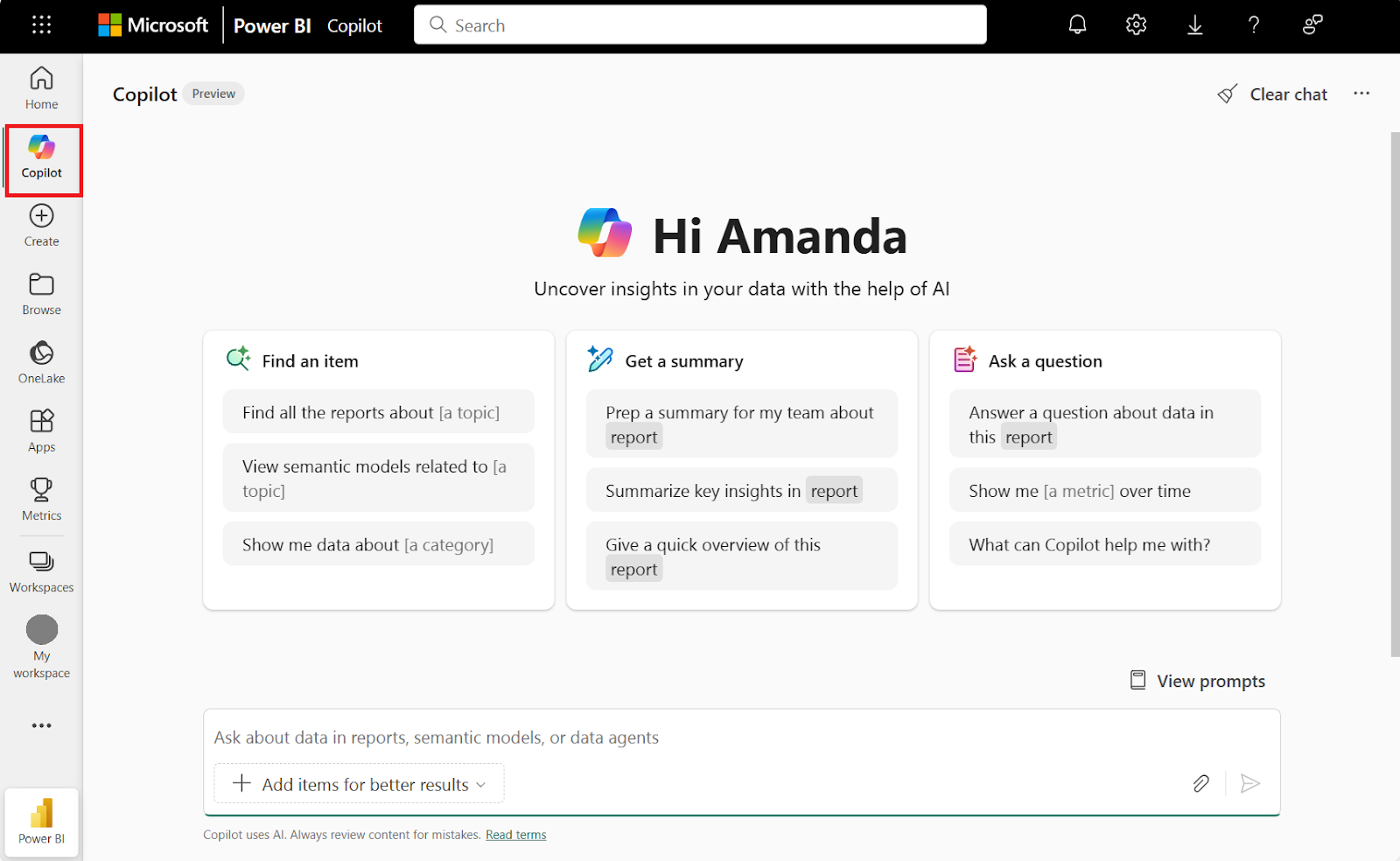
Similar to Tableau, Power BI is a business analytics solution that incorporates AI-driven features to simplify data exploration, forecasting, and insight generation at scale.
Key features:
- Natural language interface: Enables users to type questions like “What was our CAC last month?” and receive instant visualizations and summaries without SQL or code.
- AI Insights (anomaly detection): Automatically scans measures across datasets to flag deviations from expected patterns and highlight affected dimensions for rapid diagnostics.
- Smart narratives and explainers: Generates dynamic text explanations and summaries within reports, helping teams interpret trends and anomalies alongside charts.
- Decomposition tree and key influencers visuals: AI-powered visuals that let users break down numeric metrics to uncover underlying drivers and factors impacting performance.
- Cognitive services integration: Connects to Azure Cognitive Services for text mining, sentiment analysis, and image recognition, enabling richer insight from unstructured data.
How to Choose the Right AI Analytics Platform?
Selecting the right AI reporting tool involves balancing your data architecture, business use cases, and the level of AI maturity within the organization with the strengths of each tool.
Below is a structured approach to evaluating and selecting a platform that supports scalable, AI-powered decision-making.
- Step 1: Define primary use cases: Clarify what you need the platform to solve. Are you looking to speed up reporting, detect anomalies, optimize marketing performance, or automate routine analysis? Prioritize platforms that are purpose-built for your specific use cases.
- Step 2: Evaluate data integration capabilities: A platform is only as good as the data it can access. Look for native integrations with your core marketing and sales tools, cloud warehouses, and analytics pipelines. Automated data normalization, schema mapping, and update scheduling should be standard.
- Step 3: Assess AI features and usability: Focus on platforms that offer applied AI, not just modeling capabilities, but actionable features, such as natural language queries, automated anomaly detection, AI-generated reports and summaries, and smart recommendations based on historical patterns. Evaluate how these features are embedded into the UI and whether teams can use them without dedicated data science support.
- Step 4: Ensure governance and scalability: Look for enterprise-grade data governance features, such as role-based access control, data lineage tracking, naming convention enforcement, and version control for metrics and dashboards. These capabilities help maintain consistency, trust, and auditability as usage scales across teams.
- Step 5: Analyze output formats and workflow fit: Review how the platform delivers insights. Can users explore data and take action directly from dashboards? Does the platform surface insights proactively or only on request? Platforms that push alerts, recommendations, or optimization suggestions reduce time-to-decision and improve operational efficiency.
- Step 6: Consider time to value and maintenance overhead: Choose a platform that balances advanced capabilities with ease of deployment. Low-code or no-code environments and built-in automation reduce setup and maintenance time, while still providing room for customization through API access or scripting where needed.
In the end, the “right” AI analytics platform is the one that best aligns with your marketing data complexity, team skills, and business goals. A mid-sized agency may opt for an all-in-one solution that simplifies cross-client reporting, whereas an enterprise may mix and match tools to meet different needs.
Moving From Data to Decisions with AI
AI reporting tools are built to solve challenges that traditional BI tools can’t: fragmented data, slow insight cycles, and heavy reliance on technical teams for every reporting update.
By layering intelligence on top of existing infrastructure, these platforms unlock faster analysis, proactive issue detection, and more scalable performance optimization across teams and campaigns.
Improvado addresses these needs with an AI-native approach to marketing analytics. The platform connects siloed data sources, enforces consistent naming conventions, detects anomalies in real time, and delivers optimization recommendations, all without manual intervention.
To explore how Improvado can improve decision speed, data trust, and campaign efficiency, book a demo.
.png)
.jpeg)
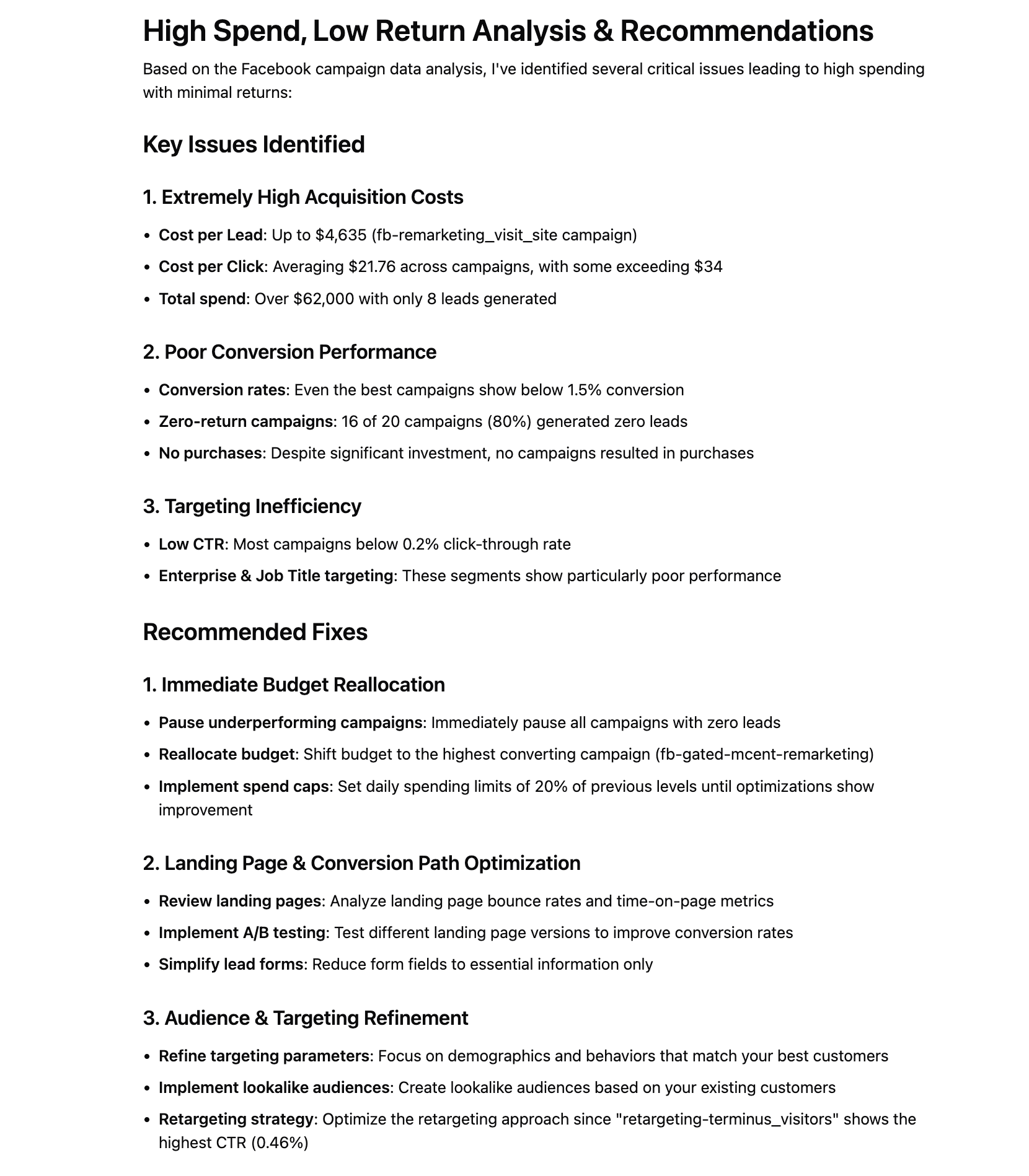




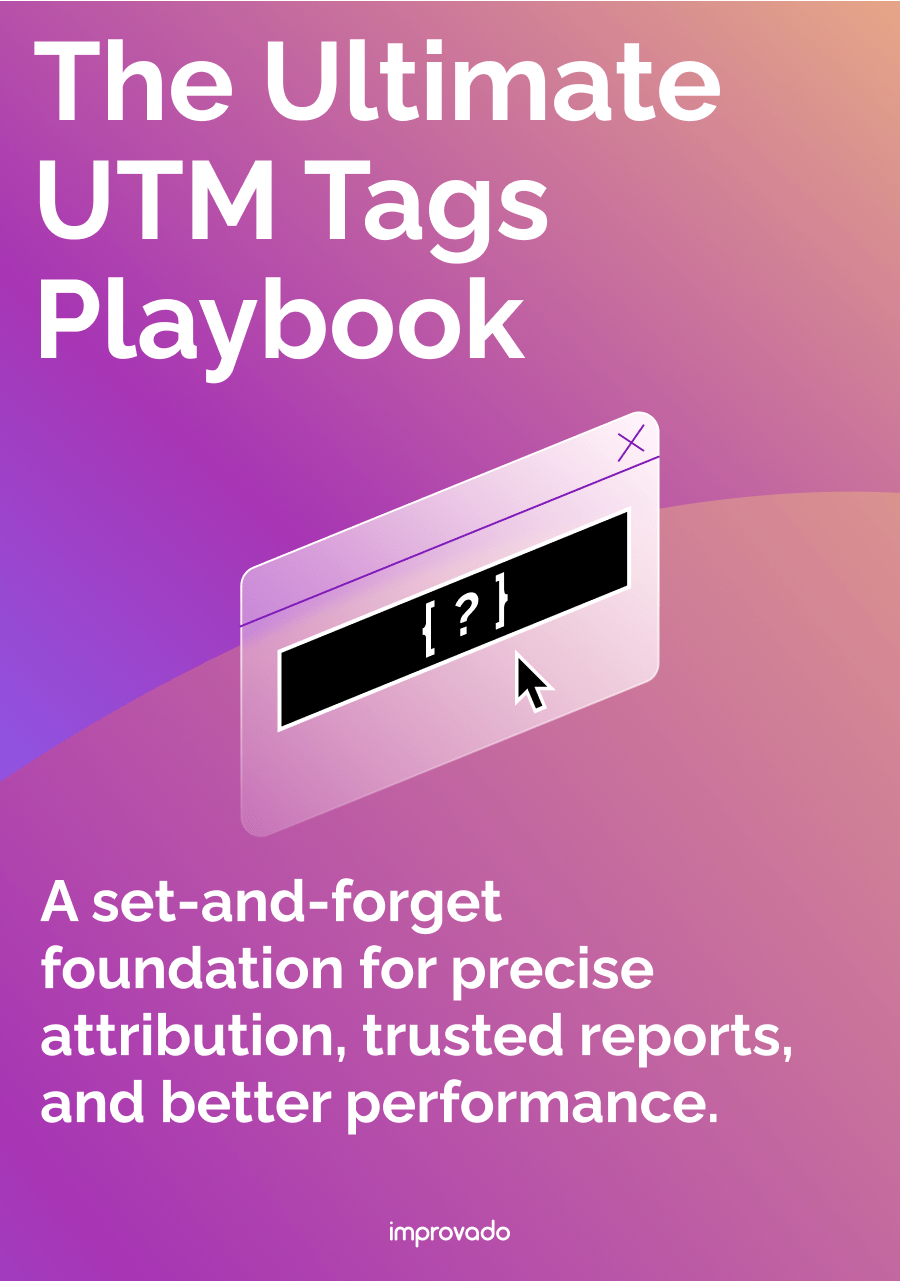
.png)
